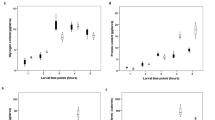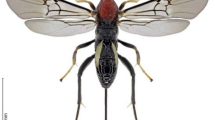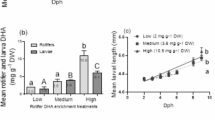Abstract
Populations of Drosophila melanogaster derived by bidirectional selection for high (HA) and low (LA) aggregated oviposition behaviour differ significantly in the duration of the larval period and adult size because of differences in the developmental profiles for feeding rate over successive phases of larval growth. Feeding rates of HA larvae are significantly lower than those of LA larvae during the flexible period of growth which precedes attainment of critical mass for pupation. Consequently the HA larvae have a slower mean rate of development. In the fixed postcritical period of development the feeding rates of HA larvae are significantly higher than those of LA larvae. This causes a greater postcritical growth increment and larger adult flies. HA and LA larvae respond adaptively by changing the expression of components of their foraging behaviour depending on whether they are in or out of food. LA larvae exhibit a more flexible pattern of response and are also more successful competitors when food resources are limiting.
Similar content being viewed by others
Article PDF
References
Bakker, K. 1961. An analysis of factors which determine success in competition for food among larvae of Drosophila melanogaster. Arch Neerl Zool, 14, 200–281.
Budnik, M, and Brncic, D. 1975. Effects of larval biotic residues on viability in four species of Drosophila. Evolution, 29, 777–780.
Burnet, B, Sewell, D, and Bos, M. 1977. Genetic analysis of larval feeding behaviour in Drosophila melanogaster. II. Growth relations and competition between selected lines. Genet Res, 30, 149–161.
Dawood, M M, and Strickberger, M W. 1969. The effects of larval interaction on viability in Drosophila melanogaster. III. Effects of biotic residues. Genetics, 63, 213–220.
De Belle, J S, Hiliker, A J, and Sokolowski, M B. 1989. Genetic localization of foraging (for): a major gene for larval behaviour in Drosophila melanogaster. Genetics, 123, 157–163.
Del Solar, E, Guljón, A M, and Walker, L. 1974. Choice of coloured substrates for oviposition in Drosophila melanogaster. Boll Zool, 41, 253–260.
Falconer, D S. 1989. Introduction to Quantitative Genetics, 3rd edn. Longman Scientific and Technical, Harlow, Essex.
Fraenkel, G S, and Gunn, D L. 1940. The Orientation of Animals Clarendon Press, Oxford.
Graf, S A, and Sokolowski, M B. 1989. Rover/sitter Drosophila melanogaster larval foraging polymorphism as a function of larval development, food-patch quality and starvation. J Insect Behav, 2, 301–313.
Green, C H, Burnet, B, and Connolly, K J. 1983. Organisation and patterns of inter-and intraspecific variation in the behaviour of Drosophila larvae. Anim Behav, 31, 282–291.
Muhammad-Ali, A Z K, and Burnet, B. 1995. Ethanol tolerance and variation at the alcohol dehydrogenase (Adh) locus of Drosophila mauritiana. Heredity, 74, 438–444.
Periera, H S, and Sokolowski, M B. 1993. Mutations in the larval foraging gene affect adult locomotory behavior after feeding in Drosophila melanogaster. Proc Natl Acad Sci USA, 90, 5044–5046.
Roberts, D B. 1986. Drosophila: a Practical Approach IRL Press, Oxford.
Robertson, F W. 1957. Studies in quantitative inheritance. XI. Genetic and environmental correlation between body size and egg production in Drosophila melanogaster. J Genet, 55, 428–443.
Robertson, F W. 1960. The ecological genetics of growth in Drosophila. 1. Body size and developmental time on different diets. Genet Res, 1, 288–304.
Probertson, F W. 1963. The ecological genetics of growth in Drosophila. 6. The genetic correlation between the duration of the larval period and body size in relation to larval diet. Genet Res, 4, 74–92.
Ruiz-Dubreuil, D G, and Del Solar, E. 1986. Effect of selection on oviposition site preference in Drosophila melanogaster. Aust J Biol Sci, 39, 155–160.
Ruiz-Dubreuil, D G, and Del Solar, E. 1991. Genetic influences on gregarious oviposition in Drosophila melanogaster. Evolución Biológica, 5, 161–171.
Ruiz-Dubreuil, D G, and Del Solar, E. 1993. A diallel analysis of gregarious oviposition in Drosophila melanogaster. Heredity, 70, 281–284.
Ruiz-Dubreuil, G, Burnet, B, and Connolly, K. 1994. Behavioural correlates of selection for oviposition by Drosophila melanogaster females in a patchy environment. Heredity, 73, 103–110.
Sang, J H. 1949. The ecological determinants of population growth in a Drosophila culture. III. Larval and pupal survival. Physiol Zool, 22, 183–202.
Santos, M, Fowler, K, and Partridge, L. 1994. Gene-environment interaction for body size and larval density in Drosophila melanogaster: an investigation of effects on development time, thorax length and adult sex ratio. Heredity, 72, 515–521.
Schöne, H. 1984. Spatial Orientation Princeton University Press, Princeton.
Sewell, D, Burnet, B, and Connolly, K. 1975. Genetic analysis of larval feeding behaviour in Drosophila melanogaster. Genet Res, 24, 163–173.
Shorrocks, B. 1990. Coexistence in a patchy environment. In: Shorrocks, B. and Swingland, I. R. (eds) Living in a Patchy Environment, pp. 91–106. Oxford University Press, Oxford.
Sokal, R R, and Rohlf, F J. 1981. Biometry, 2nd edn. W. H. Freeman, New York.
Sokolowski, M B. 1980. Foraging strategies of Drosophila melanogaster. a chromosomal analysis. Behav Genet, 10, 291–302.
Sokolowski, M B, and Hansell, R I C. 1983. Elucidating the behavioural phenotype of Drosophila melanogaster larvae: correlations between larval foraging strategies and pupation height. Behav Genet, 13, 267–280.
Author information
Authors and Affiliations
Rights and permissions
About this article
Cite this article
Ruiz-Dubreuil, G., Burnet, B., Connolly, K. et al. Larval foraging behaviour and competition in Drosophila melanogaster. Heredity 76, 55–64 (1996). https://doi.org/10.1038/hdy.1996.7
Received:
Issue date:
DOI: https://doi.org/10.1038/hdy.1996.7
Keywords
This article is cited by
-
Interspecies variation of larval locomotion kinematics in the genus Drosophila and its relation to habitat temperature
BMC Biology (2021)
-
Foraging by Drosophila melanogaster Larvae in a Patchy Environment
Journal of Insect Behavior (2018)
-
Neurotrophic actions of dopamine on the development of a serotonergic feeding circuit in Drosophila melanogaster
BMC Neuroscience (2012)
-
Plasticity and Genotype × Environment Interactions for Locomotion in Drosophila melanogaster Larvae
Behavior Genetics (2012)
-
Genetics Analysis of Larval Foraging Behavior in Drosophila Funebris
Behavior Genetics (2008)



